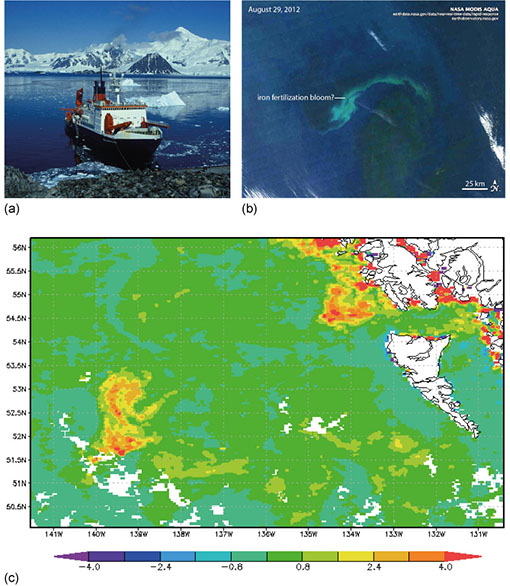3.2 Field experiments in CDR
Carbon dioxide removal (CDR) has been tested in more, and larger, process studies than SRM. From 1993–2009, several scientific expeditions carried out iron fertilisation experiments affecting a few hundred square kilometres for a few weeks in the Southern Ocean, tropical Atlantic, and north and equatorial Pacific. Two examples are the European Iron Fertilization Experiment in 2004 and LOHAFEX (taken from ‘loha’, the Hindi word for ‘iron’, and FEX, standing for Fertilisation EXperiment) in 2009 (Figure 6a). The aim of such experiments was to study the effectiveness of fertilisation at encouraging phytoplankton growth, rather than its effectiveness at removing carbon dioxide (Williamson et al. 2012). Similar expeditions have currently ceased due to the variability in their effectiveness, public controversy and concerns about regulation.
Similar and larger-scale iron fertilisation tests have also been planned or carried out by commercial interests, notably Canadian entrepreneur Russ George:
- In the summer of 2002, George borrowed singer Neil Young’s yacht to put iron-based liquid in the oceans near the Hawaiian Islands under his non-profit organisation Planktos Foundation (Schiermeier, 2003, 2004).
- In 2007 and early 2008, George’s for-profit company Planktos Inc. planned to seed a 10 000 km2 area of the Pacific Ocean near the Galápagos, and later the Eastern Atlantic near the Canary Islands, with 100 tonnes of iron particles at a time: the expeditions were abandoned after protests by Greenpeace and other environmental groups, and the refusal of the Spanish authorities to let them into their waters (Brahic, 2007; Thompson, 2008; Lukacs, 2012; Burns and Strauss, 2013, p. 273).
- In 2012, George added 100 tonnes of iron off the Pacific coast of Canada, creating a plankton bloom approaching 10 000 km2, five times larger than typical blooms in the region (Figure 6b and c; Guardian, 2012; Lukacs, 2012; Xiu et al., 2014).
While Russ George has described his projects as ‘restoration’ of the oceans, there are undoubtedly also long-term commercial aims: to sell carbon offsets and, in 2012, to be paid by locals hoping to revive depleted salmon populations. George is reported to have said his motto is ‘Save the world and make a little cash on the side’ (Goodell, 2010, p. 150; Lukacs, 2012; Hamilton, 2015; Xiu et al., 2014).
Other ocean fertilisation firms have also been set up – start-up company Climos, for example, raised $3.5 million in venture capital in March 2008, including a contribution from famous entrepreneur Elon Musk (LaMonica, 2008).

For BECCS, the first large-scale project is the Illinois Industrial CCS Project, which builds on existing smaller-scale facilities and which converts corn crops to ethanol fuel. It is designed to capture around 1.0 million tonnes per year of the CO2 emitted by the fermentation process and inject this into deep saline aquifers – porous rock that contains water several times saltier than the ocean – in the sandstone below Mount Simon (Global CCS Institute, 2015; IPCC, 2014). The aim is to implement a full BECCS system and demonstrate its economic viability (US Department of Energy, 2014), rather than test its effect on climate.
But has anyone tested geoengineering at scale in the real world?
